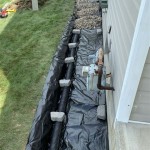DIY Basement Flooring: An Essential Guide for Homeowners
Transforming your basement from a dull and underutilized space into a vibrant and functional living area can be an incredibly rewarding home improvement project. One of the most important elements to consider when upgrading your basement is the flooring. Choosing the right flooring material and installing it properly can significantly enhance the durability, comfort, and aesthetic appeal of your basement space.
Choosing the Right Flooring Material
The ideal flooring material for your basement will depend on your specific needs, preferences, and budget. Here are some popular options to consider:
- Vinyl Flooring: Vinyl flooring is highly durable, water-resistant, and comes in a wide variety of styles and colors. It is a budget-friendly option that is relatively easy to install.
- Laminate Flooring: Laminate flooring resembles hardwood but is more affordable and resistant to moisture and wear. It is available in a variety of finishes and textures.
- Tile Flooring: Ceramic or porcelain tile is an excellent choice for basements due to its durability, water resistance, and ease of maintenance. It is available in a wide range of colors, patterns, and textures.
- Carpet Flooring: Carpet flooring provides warmth and comfort, but it is not as durable or water-resistant as other options. Consider installing carpet tiles instead of wall-to-wall carpeting, as they are easier to replace if damaged.
Essential Steps for Installation
Once you have chosen your flooring material, it is important to follow proper installation steps to ensure a long-lasting and satisfactory result. Here are the key steps to consider:
- Prepare the Subfloor: Remove any existing flooring and clean the subfloor thoroughly. Level the subfloor using self-leveling compound if necessary.
- Install an Underlayment: An underlayment provides a cushioning layer that helps reduce noise, moisture, and heat loss. Select an underlayment that is compatible with your chosen flooring material.
- Lay the Flooring: Start by laying the flooring from the center of the room outward. Follow the manufacturer's instructions for the specific flooring material you have chosen.
- Secure the Flooring: Once the flooring is laid, secure it using nails, glue, or a combination of both. Ensure the flooring is firmly attached to the subfloor.
- Trim and Moldings: Install baseboards and moldings around the perimeter of the room to give your flooring a polished finish.
Additional Tips for a Successful DIY Basement Flooring Project
- Measure the area of your basement accurately before purchasing flooring materials.
- Allow your flooring materials to acclimate to the temperature of your basement before installing them.
- Use proper tools and materials for each step of the installation process.
- Take your time and pay attention to details to ensure a professional-looking finish.
- Seal the flooring according to the manufacturer's instructions to protect it from moisture and wear.
Installing a new floor in your basement can significantly enhance the comfort, durability, and overall appearance of your home. By following these essential steps and considering the tips provided, you can successfully complete a DIY basement flooring project that will transform your basement into a space you and your family can enjoy for years to come.

Diy Basement Floor Stain And Finish 2 Colors Without Etching Youtube

15 Diy Basement Flooring Ideas Affordable Options For Basements

Best Budget Basement Flooring Ideas

Tips For An Easier Do It Yourself Garage Or Basement

Best Budget Basement Flooring Ideas

Diy Concrete Floor Cheap Home Diys Design Mom

Vinyl Flooring Install Do It Yourself Home With Krissy

Basement Flooring Ideas S Hgtv

15 Diy Basement Flooring Ideas Affordable Options For Basements

10 Ideas For Basement Flooring
See Also








